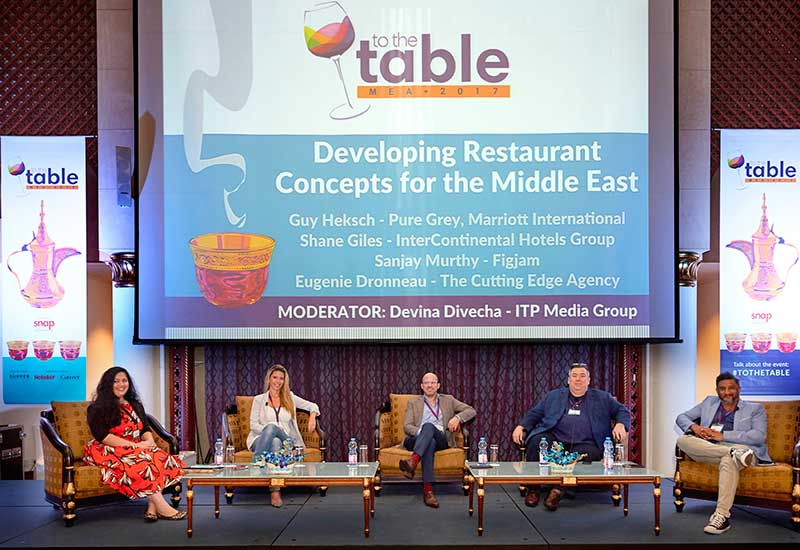Creating restaurant concepts in the Middle East is fraught with its own set of specialist concerns and considerations — quite different from the challenges and opportunities faced in other markets. One of these considerations is the time taken to open a restaurant — with this varying depending on whether it’s a hotel-based or standalone restaurant.
InterContinental Hotels Group director of food & beverage concepts, AMEA Shane Giles said gestation periods of hotels and the restaurants within them should be a considering while creating an F&B concept. He said: “The average gestation in the Middle East is around four years. So looking at trends can be quite dangerous because they are sometimes here and gone by the time we put the concept in. We try and come up with a generic food programme at a high level for the property and some of those fundamentals get tied down earlier. But with the speciality restaurants and bars, we design them out of the main programme to the point where we can have flexibility closer to the hotel opening. We hold them off to about 24 months and then have a discussion about what’s active in the market.”
Flexibility seemed to be the buzzword, with even design needing to evolve. Pure Grey vice president Guy Heksch commented: “I don’t think that when we build a concept we are trying to maximise the opportunity to change it over time because concepts’ shelf-life have actually reduced, partly because of the millennial travellers, so we’re trying to build flexible spaces and have fun with them.”

| Advertisement |
The reduction in brands’ shelf-life is a sign of the rate of change in the industry, added Figjam co-founder Sanjay Murthy, who added that the biggest shift is brands now having to design for the consumers rather than themselves. “Design has to start thinking about other elements than just the aesthetic,” he noted.
Adaptability is an element that helps prevent F&B concepts from being out-of-date by the time they open — months and years after being conceived. The Cutting Edge Agency business development manager Eugenie Dronneau agreed with Giles about revisiting concepts constantly during the construction process. Based on developing market research and trends, she said, restaurateurs need to tweak elements where necessary.
However Murthy cautioned, like Giles earlier, against following trends, labelling them “dangerous”. It can cause problems for the business, he asserted, when the execution of what’s in vogue isn’t localised. “While generic characteristics of millennials [across the world] are similar, their fundamental behaviours are different in terms of localisation of concepts. Trends are a dangerous thing to try and follow,” he commented.
In a singular situation not found in many places, independent and hotel-based restaurants are in fierce competition. Hotels are increasingly finding it challenging to make their venues more attractive than the standalones, but have the advantage of serving alcohol — something that’s slowly changing, especially in the UAE landscape, as Murthy pointed out during the discussion. However, when it came to concept creation for both, differences were also present.
Dronneau, wearing her consultant hat, said that working for independent concepts on a short-term basis is easier for consultants, and added F&B for hotels needed to be much more flexible, bearing in mind their gestation period. She added: “Correct me if I’m wrong, but independent concepts will focus on revenues but hotel concepts will focus on costs.”
Giles said: “The reason why independent restaurants focus on revenue is because they are paying rent, they’re paying utilities etc. Most hotels don’t charge rent or utilities to the outlet. So it’s artificial. And these days we have got a lot of hotel management contracts which are not written on revenue, they’re written on profit.”
He continued to talk about “speed to market” about which he believed hoteliers could learn from standalone concepts. “By the time independent restaurants [create a] concept, find a location and open, it might be 9-12 months. We’re still at a consultant appointment stage in a hotel. So freestanding restaurants are driving the speed of the industry. The second big difference between an independent restaurant and a hotel are the number of stakeholders. The biggest issue in trying to do concepts in a hotel is trying to keep the course and trying to defend the concept, preserve and keep the vision for four years,” Giles noted.
Murthy simply responded: “Brand standards”, and Heksch added: “When we create concepts we try to stay away from brand guidelines or brand standards. We believe that the restaurant should be for the local market we are in, and should be built for the locals, not the hotel guests. We really believe that if we cater for the locals, the hotel guests will want to be there. Once we have a strategy and a feasibility study, we usually get the green light as long as we stay on budget and we keep everyone out until the opening. Obviously we have to show our ROI, performance, but once we start letting everyone give an opinion… everyone’s an expert when it comes to F&B. We try to keep them from interfering.”
On that note, expectations from all stakeholders can be a particular pressure point, with the link between capital investment injected and ROI not widely understood, opined Murthy. “Inherently, if you load the business with too much capital, you are basically passing that on to the consumer. Linking capital to returns is a constant question. Especially when brands come from overseas and design from overseas without understanding the local interiors costs,” he said.
Heksch agreed and said: “Those days of building for US $10-15 million are over. We need to build with flexibility.”









 Search our database of more than 2,700 industry companies
Search our database of more than 2,700 industry companies









